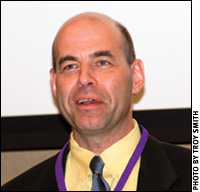ISBCW 2016:
OIE/ISO animal welfare update
by Troy Smith, field editor
MANHATTAN, Kan. (June 8, 2016) — We live in a world flooded with alphabet soup. Acronyms like ATM, FAQ, LOL and a host of others have become part of the language of common conversation. Cattle folk might talk about USDA, FSA, GMOs and NCBA, but what do they know about the OIE and ISO?
Gary Egrie, farm animal welfare coordinator for USDA’s Animal and Plant Health Inspection Service (APHIS) talked about the entities those acronyms represent during the fifth International Symposium on Beef Cattle Welfare hosted June 8-10 in Manhattan, Kan.

According to Gary Egrie, farm animal welfare coordinator for USDA’s Animal and Plant Health Inspection Service, the OIE is composed of some 175 member countries and territories whose governments collaborate in an effort to harmonize standards for managing animal health.
Egrie explained that OIE stands for the World Organisation for Animal Health. That’s confusing until you know that the group’s original name, when it organized in 1924, was the Office International des Epizooties. The new name was adopted in 2003, but the old acronym remains in use.
According to Egrie, the OIE is composed of some 175 member countries and territories whose governments collaborate in an effort to harmonize standards for managing animal health. Since 2005 the OIE has sought to provide recommendations and standards
covering animal welfare practices.
“The OIE is concerned with how countries will respond to a given issue and makes recommendations for appropriate response. The OIE doesn’t set the rules, but it sets standards that nations use in drafting their own regulations,” said Egrie, noting that the
OIE missions statement calls for “science-based” standards for livestock transportation,
slaughter and farm production practices.
Egrie said the World Trade Organization (WTO) has designated the OIE as its scientific
reference body, meaning the WTO uses relevant OIE standards when settling trade
disputes between nations.
The challenge for Egrie and his APHIS colleagues when working with the OIE is to prevent the language used in the standards from being overly prescriptive and impractical
for application in a variety of production systems.
The International Organization for Standardization (ISO), said Egrie, is a nongovernmental
organization of 161 national standards bodies that strives to implement consensus-based standards for thousands of goods traded internationally, including food.
“The ISO is trying to create platforms for business transactions using OIE standards —
essentially turning broad or vague language into technical specifications,” explained Egrie, who says reaching consensus on specifications covering animal welfare is a challenging task.
Watch for additional coverage of the 2016 ISBCW on www.angus.media and in the Angus Journal and Angus Beef Bulletin. Comprehensive meeting coverage will be archived at www.api-virtuallibrary.com/meetings_other_news.html.
Editor’s Note: The articles used within this site represent a mixture of copyrights. If you would like to reprint or repost an article, you must first request permission of Angus Media by contacting the editor at 816-383-5200; 3201 Frederick Ave., Saint Joseph, MO 64506. Angus Media claims copyright to this we site as presented. We welcome educational venues and cattlemen to link to this site as a service to their audience.
